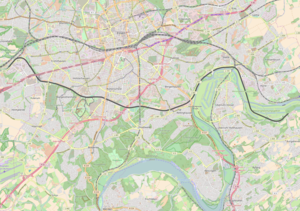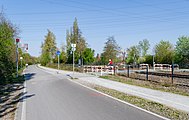Railway line Mülheim-Heißen-Altendorf (Ruhr)
| Mülheim-Heißen-Altendorf (Ruhr) | |||||||||||||||||||||||||||||||||||||||||||||||||||||||||||||||||||||||||||||
|---|---|---|---|---|---|---|---|---|---|---|---|---|---|---|---|---|---|---|---|---|---|---|---|---|---|---|---|---|---|---|---|---|---|---|---|---|---|---|---|---|---|---|---|---|---|---|---|---|---|---|---|---|---|---|---|---|---|---|---|---|---|---|---|---|---|---|---|---|---|---|---|---|---|---|---|---|---|
| Route number (DB) : | 2180 | ||||||||||||||||||||||||||||||||||||||||||||||||||||||||||||||||||||||||||||
| Course book section (DB) : | ex 232 d / e | ||||||||||||||||||||||||||||||||||||||||||||||||||||||||||||||||||||||||||||
| Route length: | 15 km | ||||||||||||||||||||||||||||||||||||||||||||||||||||||||||||||||||||||||||||
| Gauge : | 1435 mm ( standard gauge ) | ||||||||||||||||||||||||||||||||||||||||||||||||||||||||||||||||||||||||||||
| Top speed: | 50 km / h | ||||||||||||||||||||||||||||||||||||||||||||||||||||||||||||||||||||||||||||
|
|||||||||||||||||||||||||||||||||||||||||||||||||||||||||||||||||||||||||||||
The Mülheim-Heißen-Altendorf (Ruhr) railway is a historic railway connection from Heißen (today Mülheim (Ruhr) -Heißen) to Altendorf (now Essen-Burgaltendorf ), which begins in the east of Mülheim an der Ruhr and mainly through the south of Essen leads.
history
It was built from 1872 to 1879 by the Rheinische Eisenbahn-Gesellschaft (RhE), one of the four large private railway companies in the Ruhr area. It was built as a branch line on its Ruhr area line from Osterath to Dortmund, mainly to remove coal from the pits in the Ruhr Valley.
Freight traffic was started to Essen-Rüttenscheid on August 1, 1872, to Steele Süd on June 15, 1878 and to Altendorf (Ruhr) on January 22, 1879, which had already received a rail connection five years earlier. Passenger traffic on the whole route did not begin until July 1, 1879 and never achieved greater importance. The Essen-Margarethenhöhe stop was only set up in 1946 below the road bridge (Sommerburgstrasse).
Networking
Even before the nationalization of the (nominally) private railway companies, they had started to network their existing routes with one another. In addition to the RhE, the Bergisch-Märkische Eisenbahn-Gesellschaft (BME) was also active in the Ruhr area .
After it had taken over the Prinz-Wilhelm-Eisenbahn-Gesellschaft in 1863 together with its Wuppertal-Vohwinkel-Essen-Überruhr railway line and continued to build it north of the Ruhr via Steele Hbf (today Essen-Steele Ost) to (Bochum-) Dahlhausen in the same year , The direct connection from Überruhr via Altendorf to Dahlhausen followed in the mid-1870s south of the Ruhr .
Shutdown
At the end of the Second World War , on April 10, 1945, the Ruhr Bridge between Steele Süd and Altendorf was blown up and not rebuilt. From 1945 onwards, the route was only passable from Heißen to Steele Süd. Passenger traffic was stopped on this section in 1965. From 1979 the freight traffic from Heißen to Rellinghausen was shortened, in 1986 to Rüttenscheid.
Since 2001, the entire route has been closed, redesigned and converted into a cycle path . The footpath and cycle path on the first 8.6 kilometers of the former railway line is called “Grugaweg”, also known as “Grugatrasse”. It begins at the former Heißen train station, where it branches off from the Ruhr (RS1) cycle expressway .
The Rüttenscheid train station has given way to a parking lot for the Grugahalle .
Picture gallery
DGEG museum train from the Bochum Railway Museum in Steele Süd , 1978
Branch of today's Grugaweg from the Ruhr rapid cycle route (RS1) at the former Heißen train station, 2020
Web links
- Description of route 2180 in the NRWbahnarchiv by André Joost
- The Grugaweg Ruhr Tourismus
Individual evidence
- ↑ Railway Atlas Germany . 9th edition. Schweers + Wall, Aachen 2014, ISBN 978-3-89494-145-1 .
- ↑ Railroad cycling: description of the cycle path


